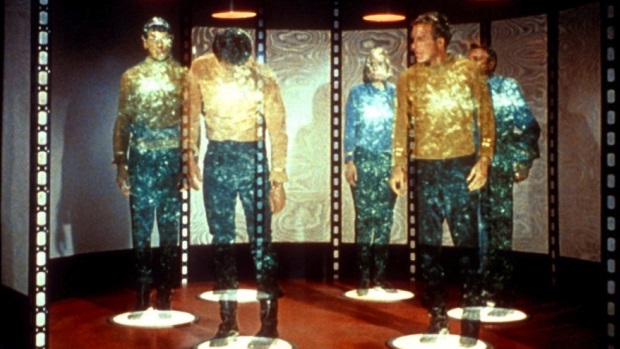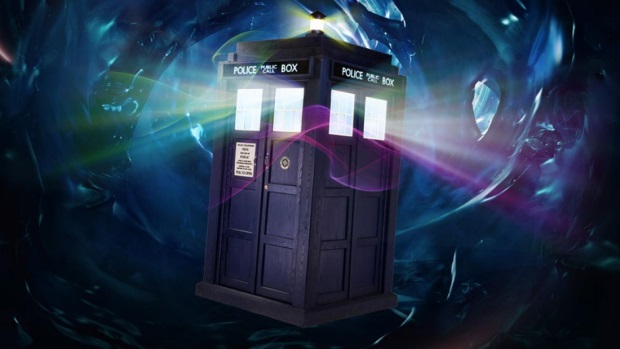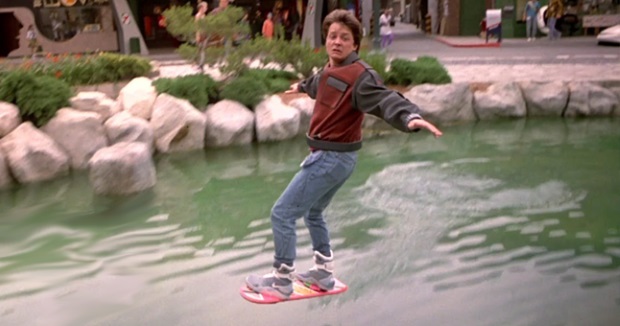AzanaBand, and how plausible is fiction tech in sci-fi?
The AzanaBand is just one example of tech in fictional sci-fi. But just how plausible is it?
If there’s one thing about science fiction that we can say embodies its appeal, it’s that we all want to know the answer to a short, simple question: What if?
What if we could instantly travel to any location across the planet? What if we could control our emotions are the push of a button? What if alien robots the size of buildings beat the hell out of each other at the end of our garden? How would it change our notions of self, not to mention the world at large?
We don’t have answers to these questions. But we do wonder how close we are to getting them. That’s why we’ve looked at some of the most famous, popular and interesting examples of technology in science fiction and tried to figure out just how close we are to getting the real thing.
After all, Arthur C. Clarke imagined the communications satellite in a novel, now society couldn’t function without them. And we waited some 35 years for flip-phones to become viable after Star Trek first portrayed them, only to find them rendered obsolete a matter of months later. What else might be on the cards?
Transporter (Star Trek)

Think about it for a minute and you can imagine that Star Trek’s transporter would, if invented, immediately revolutionise society. In addition to virtually banishing the environmental and monetary cost of transport, it would practically eliminate the barriers between countries and make neighbours of us all. It would potentially become the most important invention in all of human history and almost certainly a stepping stone on the road to a Utopian Earth.
Of course, think about it for a little longer and it becomes an existentialist PKD-style nightmare where you die every time you do so much as visit the shops, only to be replaced by a near-perfect duplicate of yourself with your face and memories. You can transport particles, after all, but can you transport a soul? (Yes, in fact all species of fish can be transported safely.)
If you’ve read this far you’re probably waiting for me to make a serious point about how a transporter might work in real life, so here we go: quantum teleportation. It’s not quite the same as a transporter, because they literally ‘transport’ matter across space (albeit through subspace, which is fictional outside of certain special interest communities). Quantum teleportation, meanwhile, makes use of a state called entanglement which allows one particle to instantly take on the properties of its entangled partner while destroying the original’s quantum state. As you can see, the Star Trek version is considerably easier to understand.
The important thing is that quantum teleportation works over great distances and immediately so, thanks to something called ‘spooky action’. If you could swap the quantum states of a large group of matter with another, you could quite literally teleport it instantaneously from place to place.
Unfortunately in real life there are a number of restrictions on how this would work, but the main hurdle so far is that so far we’ve only managed to teleport one photon a few hundred miles. Human bodies are billions and billions of times more complicated than that. Don’t hold off booking the plane tickets, that’s my advice.
TARDIS (Doctor Who)

Let’s leave aside the ability to time-travel, which has pretty much only been realistically depicted (according to the current understanding of physics) on screen once, in the 2004 indie film Primer, and instead think about the TARDIS’s other main quality: it’s cheaper on the inside. Sorry, I mean bigger. Bigger on the inside.
If you are a sufficiently well-read nerd, you might be wondering if a tesseract, also called a hypercube, might be the solution to that problem. A hypercube, in addition to being the subtitle to the movie Cube 2, is a four-dimensional version of a cube, in the same way a cube (or hypersquare) is three-dimensional version of a square. That means the hypercube (or hyper-hypersquare) has an extra spatial dimension which our universe doesn’t.
We – at least in any practical sense – exist in a place that has only three spatial dimensions, plus a time dimension. In addition to the normal three spatial dimensions of length, width and height, a hypercube also has an extra one, which in the absence of any official name we’ll call Megatron.
To describe something in three-dimensional space you only need to explain its length, height and width: 5cm x 5cm x 5cm would produce a 3D cube of 25cm volume. To describe it in four dimensions, you’d need to also add a value for Megatron. So it would be 5cm x 5cm x 5cm x 5cm. Of course, if this cube then intersected with our 3D universe, we’d only see it as a normal cube in much the same way that a cube intersecting with a 2D universe would appear to be a square. But if it was a box you could open up, then mathematically speaking it could hold as much as five normal cubes could because of its extra Megatronial space. It would, at least on paper, appear to us to be ‘bigger on the inside’.
The kicker here is that the hypercube is all a purely mathematical construct and has no apparent basis in reality. Even though some versions of string theory posit that we live in a universe with anywhere from 10 to 26 spatial dimensions, there’s nothing in the way of experimental confirmation just yet. Your dreams of living in a real-life TARDIS are, regrettably, destined to go unrealised.
AzanaBand (Kiss Me First)

Featured in Channel 4’s upcoming drama Kiss Me First, the premise of the AzanaBand (www.azanaband.com) – that it can stimulate your nervous system to produce specific emotions while you’re playing a game – certainly sounds beyond the reach of actual science, but strangely it’s one of the more plausible devices on this list. In fact, some people are already doing something similar in a practise called Transcranial Direct Current Stimulation (tDCS). That’s a book-learnin’ science way of saying they electrocute their own heads.
Now, before we go any further we should point out that we don’t endorse or recommend this. Obviously, there’s some risk attached to blithely electrocuting your own head without the supervision of a professional head-electrocuter, but worse still is that the scientific evidence for any benefits in healthy individuals could be said to exist at the intersection of sketchy and non-existent.
Despite this, recreational tDCS users attach a simple device containing a battery and a pair of electrodes to their head and pass a weak current from one side to the other, on the understanding that it stimulates the brain to produce a heightened cognitive state. Any link between the belief that this is beneficial and being the type of person credulous enough to electrocute your own head because the Internet told you to is purely circumstantial.
Whether or not it works for Reddit users, one thing that IS true is that tDCS seems to help some patients with major depressive conditions recover some of their cognitive balance. So in that sense – as an electrical device that can alter your mood – tDCS devices really are a working AzanaBand of sorts.
Hoverboard (Back To The Future Part II)

In the second Back To The Future film, Marty McFly famously jumps on his hoverboard and uses it to cyberskate his way around the robofuture in a manner that has captured the imaginations of even those of us with co-ordination so poor we can barely use doors safely. We all want to know one thing: is this ever going to be a reality?
In a way, it sort of is. The film itself leaves it vague as to how the hoverboard hovers, but we can assume from the way boards don’t work on water unless you got power that it’s probably some form of magnetic levitation (maglev) technology that pushes down against the ground. Maglev vehicles do actually exist, and maglev trains have operated in some of the world’s most advanced cities (and Birmingham). What stops them being rolled out more widely is that they’re not sufficiently better than the existing transport infrastructure to justify the cost of replacing rails with maglev.
Maglev technology also has its own problems. It’s prone to sudden inversion, for instance, which is as potentially catastrophic as it sounds. It takes a lot of engineering to make maglev trains operate in a way that stops them being at risk of spontaneously flipping over. That’s one of the reasons they run on rails, another being that you need two sets of magnetic materials to repel one another and produce levitation. A hoverboard that worked on basically any surface would need far more energy and be far less stable than existing maglev systems.
Of course, hoverboard-esque hoverboards have been created by a company known as Hendo Hover, and they even got Tony Hawk to take time away from appearing on Radio 4 (wait, is that right?) to ride it.
The kicker? They only hover if they’re on top of a specially-designed surface. And also they appear to be frictionless death traps prone to out-of-control spinning. But hey, if they can work the kinks out there’s a chance this piece of tech might one day be a goer.
The Guide (The Hitchhiker’s Guide To The Galaxy)

The Hitchhiker’s Guide To The Galaxy was imagined by Douglas Adams as a travel companion that can enlighten the reader on any subject in the entire universe. This electronic booklet contained a constantly-updated library of information which could be accessed at the push of a button, and was comfortably emblazoned with the words “don’t panic”.
When Douglas Adams invented the Hitchhiker’s Guide, the Internet was little more than a few university students trying unsuccessfully to set up a MUD and scientists writing white paper proposals describing which symbol they thought should go in the middle of an email address. Adams could not have realised how uncannily accurate his idea of the Guide would be in describing something that is, essentially, Wikipedia.
Of course, like many writers of science-fiction, Adams’ main mistake was almost that he didn’t go far enough. The Guide was a single-function piece of equipment accessing a single body of work. Most of people in whatever country you’re reading this in probably carry around a pocket supercomputer that can access all human knowledge (and whatever the hell it is my third cousins are posting on Facebook) not to mention make voice calls, take photos, offer GPS locations, and in my case, allow me to beam self-satisfied 280-character bon mots to literally hundreds of disinterested followers. If Arthur Dent had Twitter access he probably wouldn’t even have made it out of the house in the morning.
So as it turns out, sometimes reality doesn’t just match the expectations created by science fiction, it comfortably surpasses them. Whatever your favourite piece of fictional kit is, there’s a chance – a small, but real one – that it might one day join the ranks of the Taser (look it up) as a fictional gadget that eventually found itself made real.
